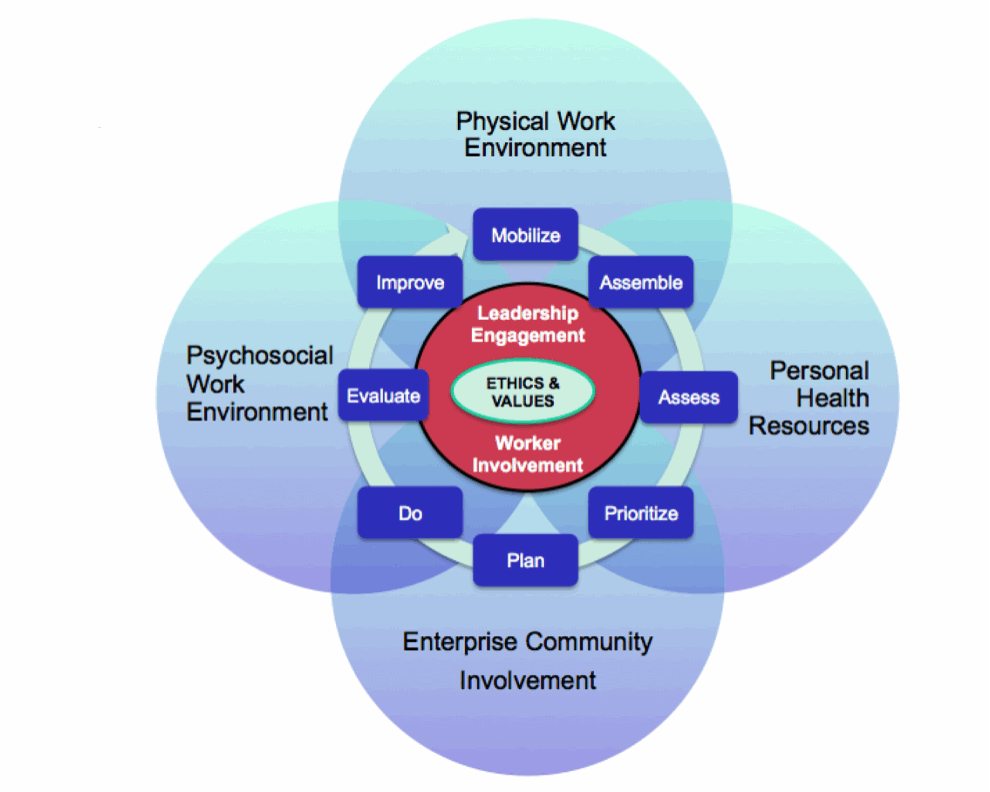Background on the Global Healthy Workplace Awards
Noncommunicable diseases (NCDs), mainly cardiovascular diseases, cancers, chronic respiratory diseases and diabetes represent a leading threat to human health and development. The rise of noncommunicable diseases (NCDs) is a global phenomenon, i.e. 63% of all deaths worldwide currently stem from NCDs and approximately 500 million people are obese and more than one in seven is overweight in the world today. Given the urgency of the crisis, for the first time in history, the United Nations held a High-Level Meeting on NCDs in September 2011. This was only the second time that the UN General Assembly dedicated a high-level meeting to a health issue (the first time being on HIV/AIDS in 2001). Coupled with the global aging trend, the need for enhanced prevention and health promotion has become a priority.
The workplace has been established as one of the priority settings for health promotion into the 21st century. The World Health Organization (WHO) Healthy Settings approach reaches back to the Ottawa Charter on Health Promotion in 1986 (“Health is created and lived by people within the settings of their everyday life; where they learn, work, play, and love”), but only recently has the WHO recognized the huge potential of improving health behaviors of individuals at the workplace, in addition to protecting the health of workers. The majority of adults spend most of their waking hours at the workplace, often as a captive audience, and thus the workplace provides a huge opportunity to inform and help workers to improve their health. The increased awareness of the workplace as a viable setting has led to an increase in programs. The Global Survey on Health Promotion and Workplace Wellness Strategies has documented a steady increase since 2007 with regard to employers recognizing their role in employee health and well-being. The key global drivers or reasons for employers offering programs are:
- improving worker productivity
- reducing absenteeism
- improving workforce morale
The issue of workforce morale and work engagement coupled with rising work-related mental illness has become a major challenge for enterprises worldwide and many programs are addressing this gap. Employees feel constantly overstressed, pressured, worried about their job security and often display a lack of motivation thus impacting prodcutivity and customer service. Other big drivers for employers are corporate image as well as recruitment and retention. The main health issues driving health promotion and wellness strategies are strikingly similar across the globe: stress (a key contributing factor to mental illness), physical activity, nutrition, work-life issues and chronic disease.
In spite of the difficulty of showing a direct link to health care costs employers outside of the US still demand high program standards and positive outcomes. In many countries a preferred outcome indicator is the sickness absence rate although we know of the limitations of absenteeism as an indicator. Measuring presenteeism is not fully accepted as a valid method and measurement instruments are often scrutinized, including in the US. A greater emphasis is placed on satisfaction scores outside of the US, especially in Europe, e.g. with the program or the workplace in general. A number of valid tools with a track record are being used in various countries, e.g. the Work Ability Index or the Q12 Engagement Survey.
Global guidance for successful programming
While a number of domestic as well as regional intiatives exist to address the lack of documentation of successful or good practices across the globe, e.g. by the European Network for Workplace Health Promotion (ENWHP) and the Health Enhancement Research Organization (HERO), global initiatives are few and far between. A notable global initiative is the Global Healthy Workplace Awards program (http://globalhealthyworkplace.org), which has set the ambitious goal to gather and disseminate better practices globally for the creation of healthy workplaces based on the World Health Organization (WHO) Healthy Workplace framework.
The WHO model provides guidance for a comprehensive and systematic approach on a global scale. Four main areas of influence are identified:
- physical work environment
- psychosocial work environment
- personal health resources
- enterprise-community involvement
 The Healthy Workplace model also follows a continual improvement process, e.g. highlighting the need for evaluation, and places leadership engagement and worker involvement as central priorities. Maybe most importantly, the very center of the model exemplifies that promoting health at the workplace is both the right thing (ethical) and the smart thing (adds value) to do. For more information on the Healthy Workplace model and initiative go to http://www.who.int/occupational_health/healthy_workplaces/en.
The Healthy Workplace model also follows a continual improvement process, e.g. highlighting the need for evaluation, and places leadership engagement and worker involvement as central priorities. Maybe most importantly, the very center of the model exemplifies that promoting health at the workplace is both the right thing (ethical) and the smart thing (adds value) to do. For more information on the Healthy Workplace model and initiative go to http://www.who.int/occupational_health/healthy_workplaces/en.
